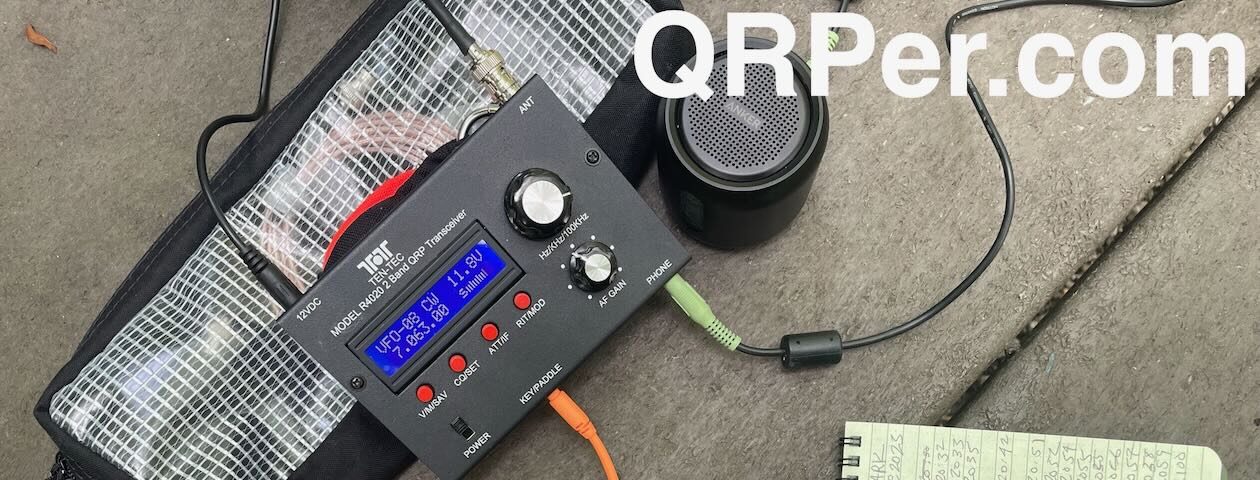Many thanks to Sam Duwe (WN5C) who shares the following guest post:
 A (surprisingly good) tabletop HF antenna
A (surprisingly good) tabletop HF antenna
by Sam Duwe, WN5C
I recently built a tabletop QRP HF antenna for 17 and 20 meters, in the spirit of the Elecraft AX-1, so I could operate at lunchtime on the campus where I teach. My wants were something small, that would fit in my work bag, that didn’t require a tuner, and could work on a couple of different bands. But on a lark I decided to attempt a POTA activation at Lake Thunderbird State Park (K-2792) pairing this antenna with my Penntek TR-35 QRP CW transceiver. I figured I’d maybe get one or two QSOs and then switch to a long wire in a tree. But what happened amazed me.
 I talked to seemingly everyone. Beginning at 9:00 AM September 26th I worked both 17 and 20 meters for an hour and a half and made 37 contacts from across the country. I even had a Swiss guy call me back on 17 but he faded before we could finish. This antenna, at least as a CW POTA activator, works. Granted conditions were very good, but I’ve replicated this multiple times in the past few weeks, just recently at a picnic table in the parking lot of the Route 66 Museum (K-8644) in Clinton, OK (there is quite a thrill in urban activations).
I talked to seemingly everyone. Beginning at 9:00 AM September 26th I worked both 17 and 20 meters for an hour and a half and made 37 contacts from across the country. I even had a Swiss guy call me back on 17 but he faded before we could finish. This antenna, at least as a CW POTA activator, works. Granted conditions were very good, but I’ve replicated this multiple times in the past few weeks, just recently at a picnic table in the parking lot of the Route 66 Museum (K-8644) in Clinton, OK (there is quite a thrill in urban activations).
It has also reasonably low profile and very quick to setup and take down. It is also quite a conversation piece when I set it up at school. I elevated the counterpoise by attaching it to a nearby oak and an interested undergrad sheepishly asked if I was listening to the tree!
The build is pretty simple. Physically the antenna consists of a small painters pole from Walmart and an old tabletop camera tripod. I found a nut that fit the screw portion of the tripod and hot glued it into the orange connecting section of the pole. That way the tripod can then be screwed onto the pole. The RF parts of the antenna consist of a 38” telescoping whip that I scavenged from the rabbit ears antenna that came with my RTL-SDR. It connects using the original connector which was hot-glued into a hole I drilled into the top of the painters pole. I found similar small 3 or 4-foot whips from AliExpress for cheap and these would probably work fine.
I then soldered a long length of speaker wire that was wound into two coils: the top for 17 meters (24 turns) and the bottom for 20 meters (25 turns plus the former 24-turn coil). The speaker wire was the soldered to the center of a BNC connector which I hot glued and taped to the pole. I soldered a short piece of wire from the shield of the BNC for the counterpoise and added an automotive spade connector to attach to a 17-foot length of wire. I also included a switch between the coils and the BNC connector to select either just the top coil (17 meters) or both coils (20 meters) using solder, hot glue, and tape. I then covered my shame in silicone tape.
The most time-consuming aspect of the project was tuning the antenna. It required trial and error to first tune the number of turns on the 17-meter coil and then the 20-meters coil. I extended the counterpoise (for me it’s best when slightly elevated) and the telescoping whip. I performed the tuning with the whip not fully extended to give room to tune in the field. Using a nanoVNA was useful here, as was soldering a pin to the wire to poke through the wire at various parts of the coil to find the best SWR.
In use, the antenna can be affected by both body capacitance and how the counterpoise is situated, so I found that an in-line SWR meter was helpful in making sure all was well. Once set up it is easy to fine tune by just adjusting the whip length. 1.5:1 SWR is about how well I can tune on average. Obviously if you have a tuner you would just have to get it close.
There are a million variation on a small base-loaded vertical antenna, and you can definitely improve upon this design. And, besides the super well-built and elegant AX-1, QRP Guys sells an interesting looking kit, and there are some good 3D printed designs I might want to try out. But regardless how you go about it, it might be worth giving a tiny antenna a shot.
72, Sam WN5C



























